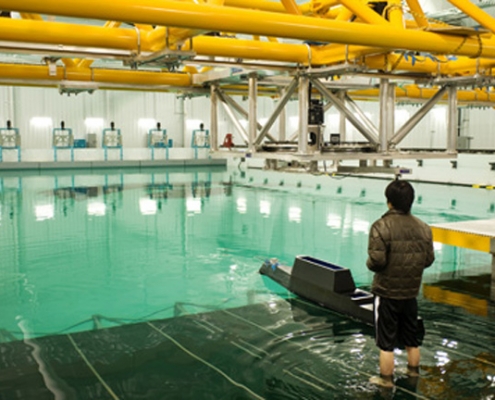Wave Basin Supports Research
Originally Posted on: January 13th, 2011
Most of us remember playing with toy boats in the bathtub as children. Believe it or not, we probably learned a few things about how water and ships interact through those early “experiments.”
IIHR’s new $4.9 million wave basin facility takes that concept to an entirely new level. Research engineers use the 40x20x3-meter wave basin to test captive or radio-controlled model-scale navy ships under a variety of real-life conditions, created by the basin’s six wavemakers. The free-moving models can maneuver just like real ships – straight ahead, zigzag, full circle, and even capsize.
The wave basin allows measurement of local flow around a free-running model—something that’s never been done before, says Professor of Mechanical and Industrial Engineering Fred Stern.
“It’s a very innovative design,” he explains. “I think that we have a key role that we’ve been playing for the navy, and will continue to play, in terms of developing the cutting-edge computational methods,” Stern says.
A custom eight-ton overhead carriage tracks the radio-controlled ships using indoor global positioning and two-camera vision, shadowing the vessels to within +/-100 mm. A 3D particle image velocimetry system will measure fluid velocities around the ships, facilitating the collection of detailed flow data. The model-scale ships can be tested for maneuvering, seakeeping, capsize, and more — potentially saving lives when the ship design is in use by the U.S. Navy.
IIHR’s wave basin is the first to include local flow measurement capabilities, critical for continued development of SBD tools. Unlike towing tanks using captive ship models, which typically allow only straight line movement with very limited side to side motion, the wave basin facility with its local flow measurement instruments can test ships under many different real-world conditions, measuring the water flow and wave patterns around the ship, including breaking waves, bubbly ship wake flows, unsteady hull surface pressure, and more.
The new wave basin at IIHR will help the U.S. Navy meet the challenges of the 21st century by supporting and validating the data gathered through computer simulations.



